Elementary fermions: the particles of matter… (Particle Physics Series – Episode 3A)
You are made of fermions, your car and your house are made of fermions, the whole planet is made of fermions. Essentially, all matter is made of a family of particles called fermions.
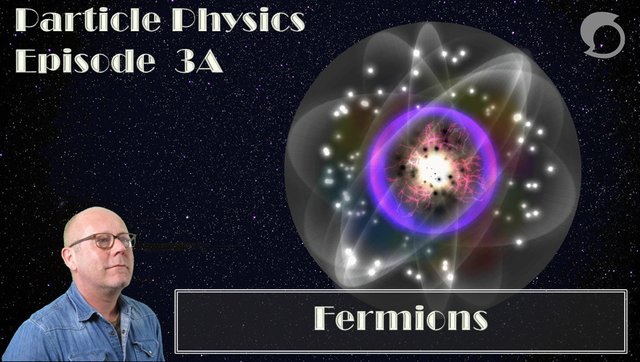
Take an atom of carbon. It is composed of a nucleus with 6 electrons hanging out around it. Electrons are elementary particles, part of a subfamily of fermions, the leptons.
The nucleus of a carbon atom consists in 6 neutrons and 6 protons. Neutrons and protons are also called nucleons because they can be part of an atomic nucleus. Both particles are composite particles, meaning that they are built from smaller blocks, quarks. Quarks are elementary (they cannot be cut in smaller parts) and are also part of the fermion family of particles.
Fermions is the family of particles that form everything we see around us, our body, our friends, our food, our environment and all the stars and planets in the universe.
These little guys deserve a little visit, don’t you think?
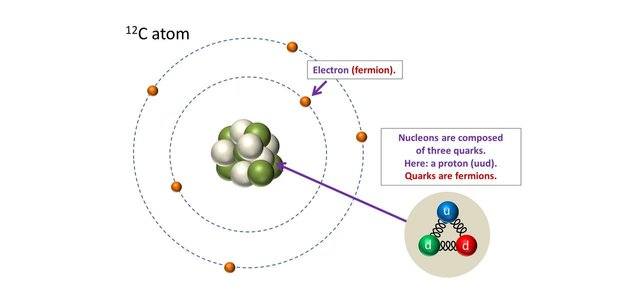
In the first episode of this series we have explored what is called the Standard Model of Particle Physics, that lists all elementary particles (including fermions) and describes their interactions.
In the second episode, we have learned about the rules defining how composite particles can be formed from quarks. These composite particles are called hadrons which include baryons (neutron & proton) and mesons (pions and kaons).
Interactions between particles and their resulting behaviors originate from their intrinsic properties. What are these properties? How are they described? What consequence do they have on the particle’s behavior and interactions and ultimately on our reality?
This episode is aimed at giving you some answers. However, this is a huge sub-topic of particle physics that could deserve a whole book. This is why I decided to divide it in 5 papers.

- PART 3A (this article) reviews the elementary fermions that exist and describes their properties by introducing the concept of quantum numbers.
- PART 3B focuses on one specific property: the mass of fermions. We will also compare their individual mass with that of the composite particles they form: that will make us understand something really important about what matter really is.
- PART 3C discusses a key concept in particle physics: quarks hate being alone… they have to exist in the confines of a hadron… We will see why…
- PART 3D makes us travel the other side of the mirror and discover the thrills of antimatter.
- PART 3E freaks us out when we realize that our world is invaded by trillions of trillions of mysterious ghost particles called neutrinos (neutrinos are leptons, thus elementary fermions).
I produced a video for my students corresponding to a lighter version of the content of this article. Feel free to check it out before reading further!
1/ Our reality is made up of 17 elementary particles
We have seen in the first episode that the standard model of particle physics consists in 17 elementary particles. Among them, there are 6 quarks and 6 leptons that group into a larger family: the fermions. These are the particles of matter.
There are also 4 bosons, which are the particles of force: These are involved in the propagation of the forces between fermions. The photon carries the electromagnetic force. the gluon transmits the strong force that stick quarks together to make nucleons and hold the nuclei of atoms together. W+, W- and Z0 bosons are the vectors of the weak force that plays a role in transforming quarks in one another like in a beta decay. Finally, the hypothetical graviton is supposed to be the carrier of gravity.
There is a 5th boson, very different from the others and with a crucial role: it is responsible for the mass of particles!
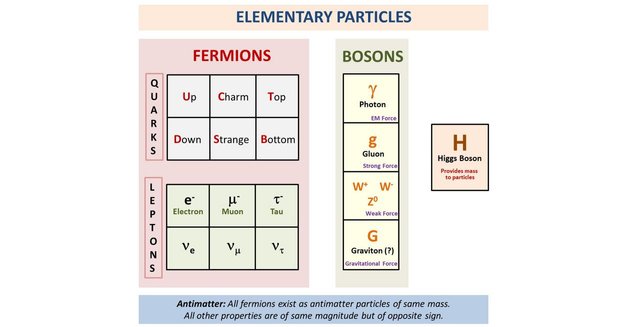
2/ What are fermions exactly?
In high school physics text books, fermions are often defined as being the particles of matter. This definition is actually incorrect because too restrictive.
What indicates if a particle is a fermion or not is how it appears to spin on itself. Fermions are particles, elementary or not, that have a value for their spin which is a half integer (1/2, 3/2, 5/2 etc…). For example composite particles like neutrons and protons have spins which are half integer, so these behave also as fermions.
In this paper we will limit ourselves to elementary particles, therefore elementary fermions.
The spin of all elementary fermions is 1/2.

3/ The spin of a particle? What does it mean?
Particles have magnetic moments. The magnetic moment of a body is associated with the torque (understand a rotating force) it would experience in a magnetic field. This torque leads naturally to an angular momentum, i.e. the spinning of the body around an axis.

Because particles have magnetic moments, it is inferred that they must be spinning. Yet, in absolute, this idea is incorrect. A particle is not really a little sphere with a definite surface so it cannot really spin on itself in the Newtonian sense.
Still, I do allow myself to represent Spin like a self-rotation as it is way easier for the human mind to visualize than just talking about an abstract property. I also represent in my mind the value of Spin as the direction of the rotation (clockwise or anticlockwise) combined with the relative direction of the axis.

Spin has a huge impact on the collective behavior of the particles:
The spins of all Fermion are half integers. This implies that fermions must obey Pauli’s exclusion principle that states that two identical fermions (i.e. sharing the same state) cannot have the same position and momentum.
In contrast, bosons, the other main family of particles (photons, gluons etc.) have a spin value that is an integer value (0, 1 ,2 …). This implies that Pauli’s exclusion principle does not apply and that we can observe multiple bosons behaving as if they were a single one.
A typical example is the laser: all the photons emitted are in the same state.

Another example is the Bose-Einstein condensate where atoms for which the spin adds up to an integer number (making them bosons) are cooled at such low temperature that they become indistinguishable from one another. In other words they become one super atom!
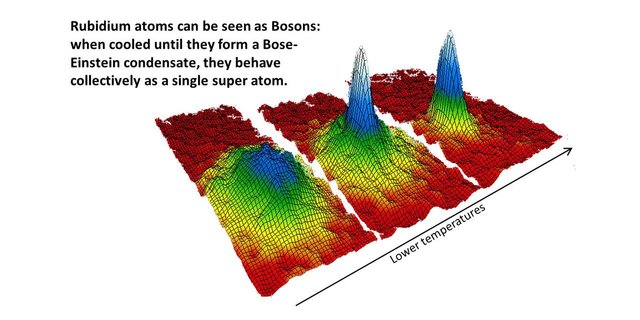
As you can see, Bosons can exhibit some pretty funky behaviors. We will discuss more about these little guys in a future episode. promise :-)!

4/ What are Quantum Numbers?
In the previous paragraph we have discussed a fundamental property of particles, called spin. The value of the spin defines if this particle is a fermion or a boson, thus characterizes its behavior and interactions with its environment. Spin is limited to a set of fixed values. Spin is an example of what is called a quantum number.
Objects have properties. Take for example the pen below:

This pen has intrinsic properties: a mass (about 20 grams), a color (it is blue), a shape (it is cylindrical) etc.
Particles also have intrinsic properties. For example, an electron has a spin, a charge and a mass that is intrinsic to the fact that it is an electron. For elementary particles, many of intrinsic properties can only take a set fixed of values: they are quantized and thus can be represented by a quantum number.
A good example of a quantum number is the electric charge Q. For quarks, it can only be (2/3 or -1/3) while for leptons it can only be -1 or 0 (inverse the sign for anti-quarks and anti-leptons).

5/ Quantum numbers of elementary fermions
Let’s go through the main quantum numbers that describe the properties of Fermion.
Spin: As we have seen, quarks and leptons are elementary fermions, therefore they have a quantum number Spin equal to ½. The notation is J. The spin defines their collective behavior and interactions with the environment.
Electric Charge: We also mentioned the electric charge, noted with the letter Q. The electric charge defines if and how the particle will trigger the electromagnetic force. The up, charm and top quarks (the happy quarks) have an electric charge of +2/3, while the down, the strange and the bottom quarks (the depressed ones) have an electric charge of -1/3. The electron-type fermions, which are the electron, the muon and the tau have a charge of -1. The neutrino, like their name suggest are neutral: their charge is zero.
Baryon Number: Another important number is the baryon number, noted B. It defines how much of a baryon is a particle. All quarks have got a baryon number of 1/3 because they are a third of a baryon. For example, a proton is made of 2 ups and 1 down, that is B = 1/3 + 1/3 + 1/3 = 1. It confirms that a proton is a baryon. Leptons on the other hand are not baryons, they cannot assemble to build baryons, so their baryon number is 0.
Lepton Numbers: Leptons all have a lepton number of 1, because they are leptons. The symbol for this quantum number is L. Quarks are not leptons, so their lepton number is 0. The lepton number is actually a sum of three lepton numbers: The electronic lepton number + the muon lepton number + the tau lepton number. For example, for the muon, the lepton number is 1 because it is 1 for the muonic lepton number and 0 for the two others: L = 0 + 1 + 0 = 1.

Strangeness: Another number often mentioned in high school physics text books is Strangeness, symbolized by the letter S. The strangeness of a particle defines how much it has the characteristic of a strange quark. So it is non-zero for the strange quark and zero for all other particles. The strangeness of the strange quark is -1. For example the meson K- (ūs), a composite particle made of an anti-up quark and a strange quark has a strangeness of -1.
Charmness, Topness and Bottomness: Other similar quantum numbers exist as charmness (C), topness (T) and bottomness (B) expressing how much of the characteristic of a specific quark is possessed by a particle. The charm quark has a charmness of +1, the top quark, a topness of +1, while like the strange quark, the Bottom quark has a bottomness of -1.
Other quantum numbers : Other quantum numbers exist and are assigned to elementary and / or composite particles. These are also applied within conservation laws to deduct if an interaction or reaction does or does not occur, and also hint on which of the fundamental forces is involved.
For example, the quantum number called “hypercharge”, noted Y, is conserved when the reaction occurs via the strong force but is not conserved necessarily if it is the weak force that is involved. Another quantum number "weak isospin" (noted T3) relates to the weak force. It is always conserved for all interactions whatever the fundamental force involved. The only exception is when the interaction is with the Higgs field. In that case, it is a specific linear combination with another quantum number (the weak hypercharge, Yw) that is systematically conserved.
We will not go in the details of these other more complex quantum numbers in this series of articles. However, one thing to remember is that in all interactions, it is the conservation or non-conservation of quantum numbers that give the clues when investigating interactions between particles.

6/ Quantum numbers are used to determine what can and what can’t happen
Many of you know that in chemistry, when there is a reaction, charge must be conserved, right? For example, in the oxidation reaction of hydrogen, the initial electric charge of the system is zero, and the final charge is +2 – 2 = 0.

The total charge of the system stays the same: it is said to be conserved.
In particle physics, this principle is absolutely fundamental. In nearly all interactions between particles, conservation laws apply to quantum numbers. If there were only one reason for which quantum numbers were invented to define elementary particles, this would be it!
Let’s consider a simple particle physics reaction to exemplify. Let’s consider the decay of a positive pion into an anti-muon and a muonic neutrino, and let's observe how quantum numbers change.
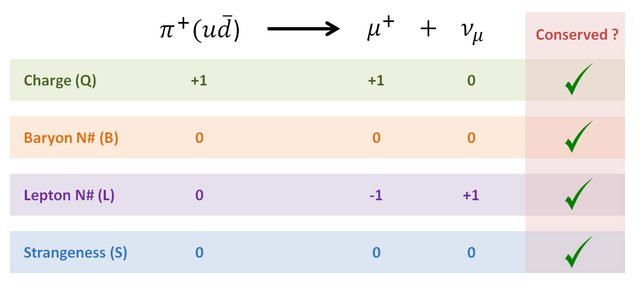
As you can see, all quantum numbers are conserved. This means that this reaction is possible. This concept of conservation is a critical aspect of particle physics and will deserve a full blown episode…

7/ Conclusion
Quantum numbers are a fundamental concept used to describe the properties and interactions of elementary particles, including fermions. These indicators allow us to predict if a reaction could occur or if it is just plain impossible.
We have listed these properties for fermions, but we did leave one aside on purpose: mass… In the next article, we will be approaching the concept of mass for elementary fermions, and from what we will learn, realize quite some amazing facts about our reality...

The 'Particle Physics' series is aimed at providing an introduction to the world of small scale physics to non-scientists and high school students preparing for their high school exams.
Previous episodes:
Need some more particle physics?
If you wish to sharpen your understanding by approaching particle physics via another angle, please explore @lemouth series of articles on particle physics. You can start here: https://steemit.com/science/@lemouth/the-bestiary-of-particle-physics-this-is-how-i-introduced-particle-physics-to-cern-summer-students

Sources, references and to dig deeper:
Image credit:

Hi,
I’m @muphy (see intro post),
My life revolves around music production, teaching sciences, and discovery through travel.
You enjoyed that post? Resteem and Upvote!
You are interested in these topics? Follow me!
Hi Muphy! Very nice post! I have, as usual, a couple of comments :)
This is strictly speaking incorrect, as the Higgs boson interacts with photons and gluons too, while these two are massless. The trick is that those interactions are higher-order ones (they arise via virtual loops of intermediate particles).
A very nice exercise you could ask to your students would be to calculate the rotation speed of the electron, if it would be spinning on itself. Knowing that its radius has to be smaller than 10-18m, one can show that the rotation speed is larger than the speed of light.
I find this very confusing, as isospin does not act at the same level as the other examples you present, as it concerns the non elementary level. I would stress the difference.
This is also confusing. I actually don't see what you mean. Note that we denote hypercharge simply as hypercharge (we are don't usually say 'weak' here).
Higgs Bosons interacts with mass-less particles? I didn’t know that. The data on the web is quite confusing. Would you mind suggesting a reference that explains that ? I reformulated the sentence in the article to avoid suggesting a non-interaction of the Higgs with mass-less particles.
You are 100% right, I checked it out. Isospin applies to Hadrons… I edited the text for that too.
Maybe we are not referring to the same Quantum Number here. Not mentioning the word 'weak' implies the hypercharge of the Strong force. I was talking of the weak hypercharge, a quantity that changes when interacting with the Higgs Field… What is conserved in such an interaction is a linear combination of the weak hypercharge and weak isospin, that actually is just the electric charge. You can reformulate the combination to put Yw as subject like this : Yw = 2(Q –T3).
Yet overall, you are correct, the way I wrote this paragraph does nothing else in my paper apart from bringing confusion, especially that I am a little out of my comfort zone here, and learning at the same time ;-).
I edited the paragraph to emphasis the idea that many other quantum numbers (like Hypercharge, weak isospin and weak hypercharge) combined with conservation rule are used to predict the existence or non-existence of given interactions and help deduct which force is involved. I would really appreciate if you could check if the way I reformulated the idea is correct ?
Thanks for your great comments. These make me progress in understanding the wonders of nature :-)!
The main discovery channel of the Higgs bosons was through its decay into a pair of photons. The bulk of the Higgs boson events at the LHC arises from its production in the gluon fusion channel. The interactions are not direct but are loop-induced (see here for a graph). There is no free parameters depicting those interactions of the Higgs with gluons or photons. They are fixed by all the other parameters of the theory.
More preciseyl, you can check here but the literature is pretty dense. You can also check the Physics Reports of Djouadi (here), but again, pretty intense.
There is no 'hypercharge of the strong force'. In the Standard Model, the hypercharge is an interaction as its own, like the weak interactions and the strong interactions. The Higgs field is charged under the hypercharge, as any other Standard Model particles. The hypercharge quantum numbers are thus fixed from the start and constant. They do not change.
The electroweak symmetry consists of the weak interactions and the hypercharge interactions, and it is broken down to electromagnetism. In short, the union of the weak and hypercharge symmetry groups include somehow electromagnetism, which is why you can relate the electric charge to the hypercharge and the weak isospin.
I have never written on this so that I have no clear post to advertise. Should I? :D
I understand what you mean now concerning the Higgs-massless particle interactions. Thank you for the links, indeed, they report pretty high level information, and to be honest, it kinds of fly above my head (Even if I have a PhD in physical chemistry, my uni cursus never brought me in a Particle Physics class... I am 100% self-taught in that subject).
When I was referring to the Hypercharge of the strong force, I was referring to the linear combination of the flavor numbers (charmness, topnesss etc…) + Baryon number (B+S+C+Bt+T) that is conserved during strong interactions but not during weak ones. (Ref: https://en.wikipedia.org/wiki/Hypercharge). i.e. I was considering it like a quantum number...
That confuses me a little... For me an interaction between particles implies one or more of the fundamental forces, there are only 4 known. Maybe you mean that the hypercharge is what we call the force taking the place of the EM and Weak force when these combine together at ultra high energy (above the higher energy threshold below which the electroweak symmetry breaks, corresponding to a first few instants after the Big Bang)?
Actually, that would be a good idea. In absolute, is it possible to discuss Particle Physics at this level while staying in Layman terms (so that even a high school student could appreciate fully the content). The first episode could be to define terms like what are symmetry groups, how they are manipulated to reflect reality and predict what happens and what does nor happen… It could be the step up from my own series for those that wish to dig deeper (like me ;-).
Okay for the strong hypercharge. This is actually something that is never used in the field (it is kind of obsolete, as written at the end of the wikipedia article). This is also the reason of my confusion :)
For the interactions, I am now writing a post about it, in the next part of the particle physics crash course for the meetup. By the way, can you come? The deadline is over but I can make an exception for you if you answer me by tonight.
Hey @lemouth. You must have missed my post on Discord. When I looked into the visit in detail, my enthusiasm was a little eroded by what it implied for me in terms of schedule... I thought it would be OK, but it really disrupts my other commitments.
February till May is really the big time of the year for my teaching activities. So I was disapointed when I realised I had to back out of this amazing opportunity to visit the LHC and meet other Steemstem members in such an environment. Mais clairement, pour moi, ce n'est que partie remise!
Hi @muphy! Yes indeed I missed your post. Too bad, but maybe in 2019...?
By the way, you mauy want to check my crash course on particle physics 2 course. I added a section just for you ^^ Please let me know whether it clarifies.
It did, thank you so much: It allows me to explore further. I commented on the post, to check if I really got it, and also to obviate a confusion I might still have concerning the electro-weak interaction.
For 2019, Sure, I would love to, and this time I can organize myself in order to not have a collision of commitments. How long in advance do you think you could be able to know a date?
Hi @muphy, I can't tell you how much I am enjoying this series of posting! Really fantastic job of breaking this all down into manageable bite size pieces - I think you made the right formatting choice to NOT do one giant post / video. As someone who has not taken any sort of physics since the high school level myself, you have hit the perfect level of detail in your explanations. I was easily able to follow along and I think I am even getting it, by George!
This post was nominated by a @curie curator to be featured in an upcoming Author Showcase post on the @curie blog. If you agree to be featured in this way, please reply and:
You can check out the previous week's Author Showcase to get an idea of what we are doing with these posts.
Cheers - Carl (@curie curator)
Hi @carlgnash
Thank you for your great comment about my series on Particle Physics. It really makes my day!
Sure, feel free to quote any section of text, picture or illustration that is relevant to the Author Showcase. I feel honored :-)
I am sending you an author statement on Discord (@Muphy#9345). Feel free to use the statement partially or fully, as you believe is relevant. You can also check my intro post if you wish.
https://steemit.com/introduceyourself/@muphy/introducing-myself-greetings-steemit-community-this-is-edouard
Be well
The author showcase post is up :)
https://steemit.com/curation/@curie/curie-author-showcase-january-18th-2018
It's good you are breaking this up, I was doing pretty well but then my brain was fried about 3/4 of the way through, I will have to process all that for a while as I just learned more about particle physics than I did in high school
Thank you for the feedback. My brain was fried too when I finally clicked on 'post' haha.
If you are interested in particle physics without risking a headache, check out the videos associated with the posts, the explanations are less in depth, and easier to grasp than in written form.
Start with the video in episode 1, then the one in episode 2, and finally the one in this episode.
https://steemit.com/science/@muphy/elementary-particles-the-building-block-of-reality-particle-physics-series-episode-1
https://steemit.com/science/@muphy/composite-particles-let-s-play-lego-particle-physics-series-episode-2
and for this episode:
Enjoy!
Thank you, reading is hard! I can't believe no one ever told me about fermions.
I'm not here to comment on the content of the post but on the beautiful formatting. Well done and a good example of what can be accomplished here!
Thank you, that comment means a lot to me!
In my opinion, formatting is really important in the process of passing on information. Particle Physics is often perceived as a difficult topic, so an aerated article with short paragraphs and clear illustration, is essential to give a break to the reader. That way, the info has the time to sink in, so that the reader can move on with confidence to the next paragraph.
Consequently, I do spend quite some time refining the presentation of my posts by resizing illustrations, and playing with html tags.
Thank you for noticing, you are the first :-)!
Do you think that quantum physics will help humanity after we manage to develop quantum computers(which hopefully will appear in the next 10-15 years)?
Hello @ fujiwara, well it depends...
It is already heavily integrated in our technology you know (for example, lasers in CD players, classical computer chips and components).
Do you think that with some perspective, humanity is better off now than before? Ultra fast computer based trading that decimates real economies, that would be a serious con, but I suppose also that instant communication has minimized and even solved many problems... So it's up to your own appreciation.
We do not really know what would be the effect of quantum computers on humanity. With such a calculation power, the emergence of AI could be possible. Will it be benevolent (and solve all humanity's problems), or will it be malevolent (Terminator and Skynet... hello!)...
Actually, what I enjoy when studying and teaching particle physics, is not the technological perspectives it can provide, but getting closer to understanding nature....
"Ultra fast computer based trading " seems like it will be the first practical application of entanglement, right now they all compete to see who can be physically closest to the exchange so they can trade faster than the other guy.
It has already been happening for years... unfortunately (Classical computers are way fast enough )
right but with a quantum communications you would not need to be physically close to the exchange, there would be no delay at all or advantage of physical proximity.
I think you might still have the old view of the exchange with people shouting orders... I am not 100% sure, but I believe 99.9% transactions now are carried out by computer (i.e. from any place in the world in any market in the world...).
my understanding is , if I have a trading computer and you have a trading computer and mine has a 1 picosecond delay and you are twice as far away and have a 2 picosecond delay then I win. But quantum communications would make it literally instantaneous, there is not any delay with entangled particles right?
Oh, but here you are talking about entanglement... it's more of a communication issue than quantum computer processing power... if 2 particles entangled, there would be no delay, would you be 2 blocks away or the other side of the universe ...
Quantum theory is really fascinating to understand but tough
It is fascinating: I sooo agree.
Yet, not as tough as you imply: check the videos (I posted them in one of the comments above). They provide an easier path to understanding the building blocks of nature.
this seems excellent very mind blowing things to learn i am not the most intelligent to debate on this but still thank you for sharing in simple words
Hello Megha,
Don't underestimate yourself! I decided to be a private teacher because I strongly believe that anybody can understand these things. And this belief system works: I have seen miracles with some of my students that originally were seeking help because they were completely lost in Physics. Today, they are writing to me and thanking me because they are enjoying their high level physics studies in great universities!
If you are interested in this topic and want to give it a shot, just for fun. Start with the first article: https://steemit.com/science/@muphy/elementary-particles-the-building-block-of-reality-particle-physics-series-episode-1
Be well
Very solid presentation and a good primer to particle physics. Thanks a lot. I would also be interested in your thoughts relating to string theory, assuming you are familiar with the subject.
Thank you for the nice words @jaalig.
String theory, that is one serious step deeper into small scale Physics, and at the same time such a vast topic!
What I know is that the 2 theories which are taken the most seriously by researchers are String theory and Quantum loop gravity. I read a paper article recently that lead to a fascinating result. Considering the hypothesis of the holographic universe (for example, when all physics inside a sphere is described on its surface), both theories seem to converge towards the same maths, while they are sitting on radically different basis.
If I have the time in the future, I will dig to evaluate if there is a real reason for enthusiasm . Because if this is correct, that means that both theories are two facets of the same coin. Implications could be quite mind blowing...
incredible my brother @muphy. Fermions for the essential of the creation of all that exists.
Fermions are the particles of matter... and there are bosons: these will stick fermions together... So, actually it is the combination of both bosons and fermions that make reality.
thanks for the explanation my brother @mubhy. I will be resteem your posted
Thank you :-)!